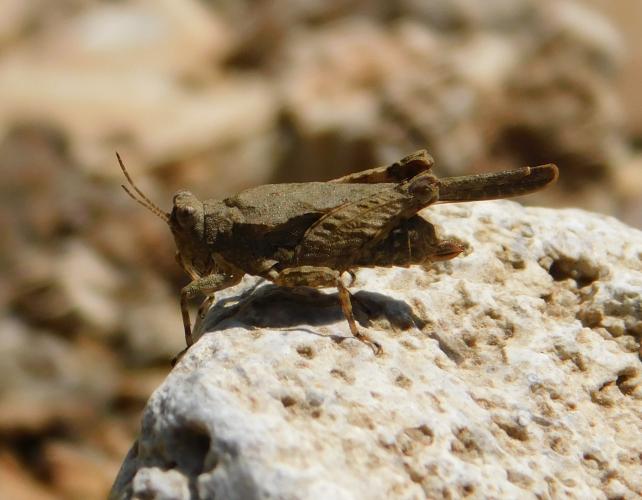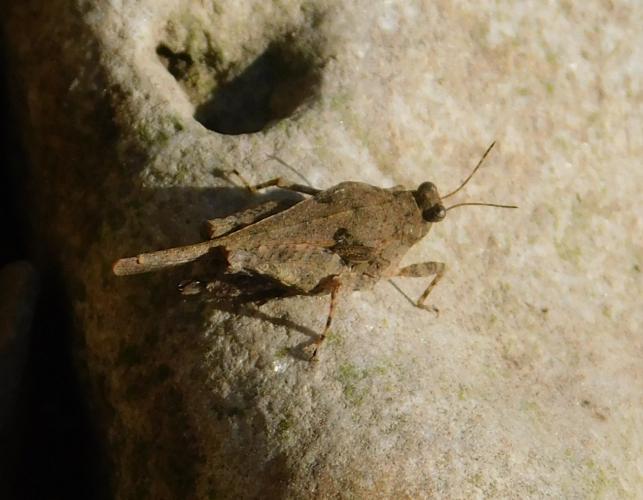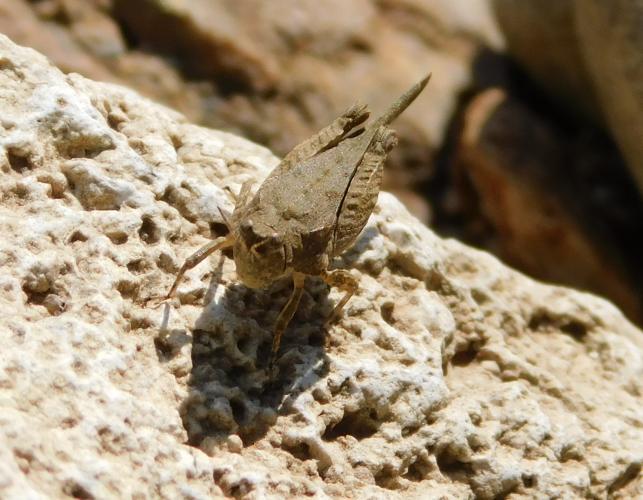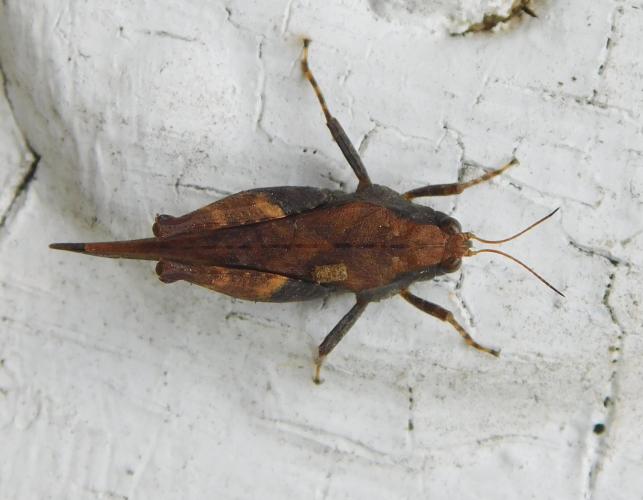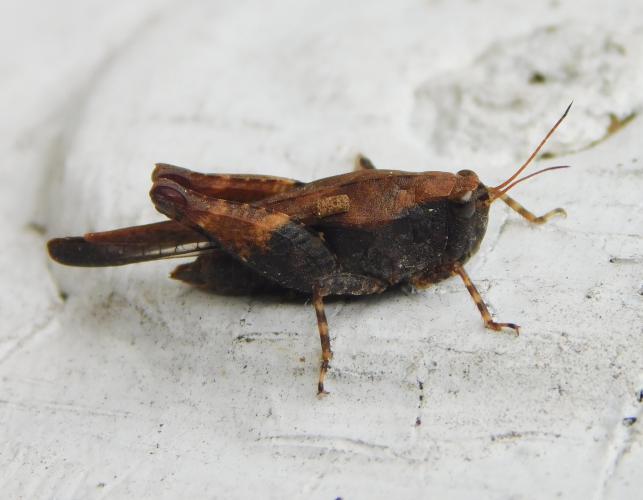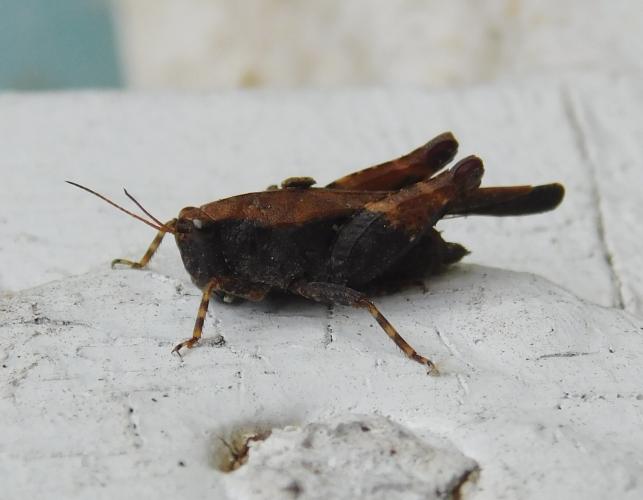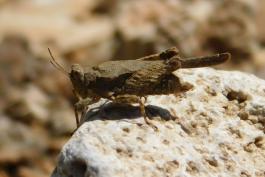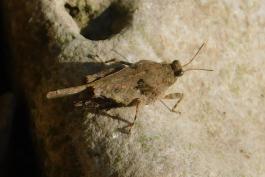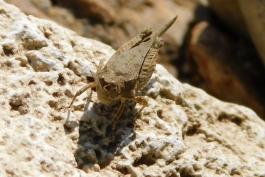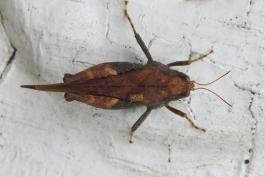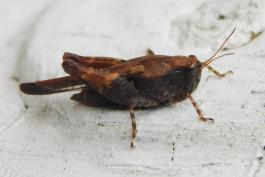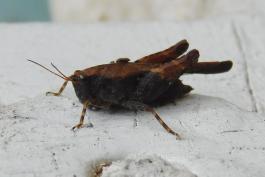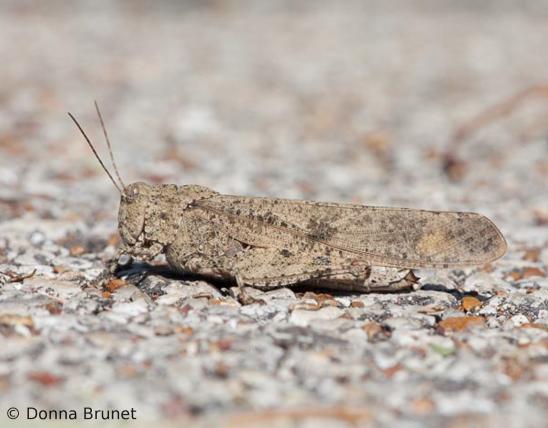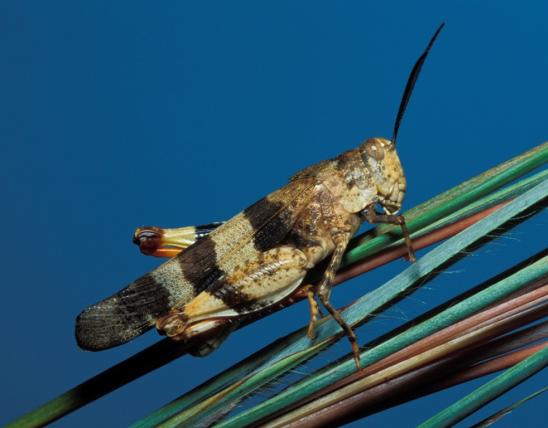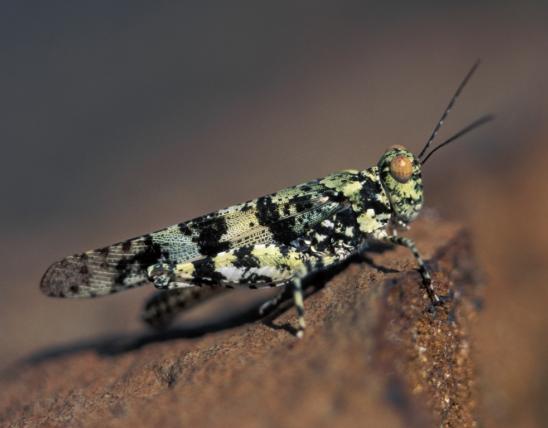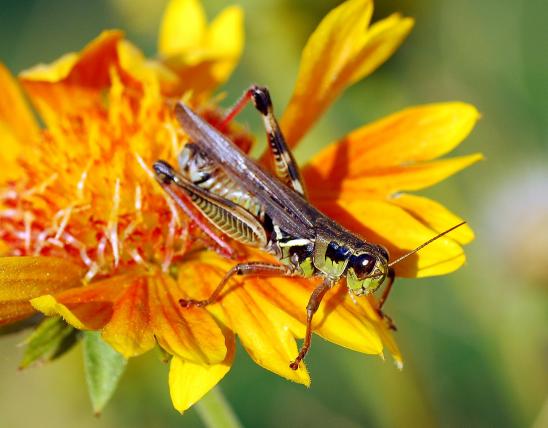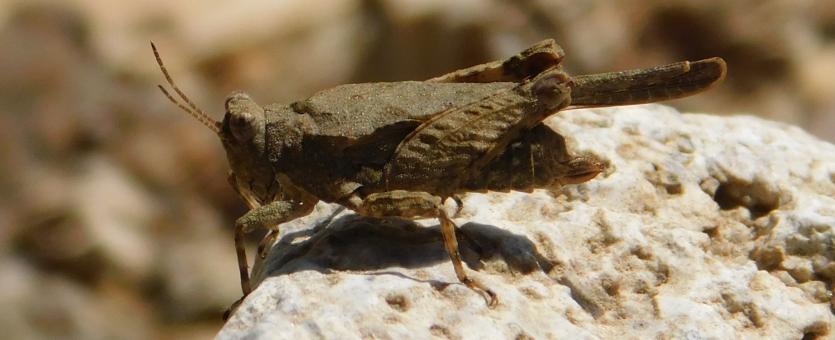
The pygmy grasshopper family is well named, since most species are quite small, never exceeding ¾ inch. Many live near streams or ponds, or in wet or damp places, and some are even semiaquatic. A key identifier is their long, tapered pronotum — that’s the plate at the top of the thorax, behind the head, which in most grasshoppers is quite short and shoulder- or mantle-like, ending about where the wings arise. In pygmy grasshoppers, the pronotum is so long that it usually extends clear over the abdomen, covering or mostly covering the wings.
Other identification tips include:
- Coloration is usually drab and camouflaged; it often varies within a species depending on the local soil or rock color. For species-level IDs, light-and-dark patterning is more helpful than particular hues.
- Foot (tarsal) segments are 2 in the front pair, 2 in the middle pair, and 3 in the hind pair.
- Forewings (tegmina, which are leathery covers in most other grasshoppers) are small and padlike (or absent) in pygmy grasshoppers.
- Flying wings (transparent and veined; technically the second pair) are either short or long, sometimes varying within a species (thus certain species can have both “short-winged” and “long-winged” forms); sometimes wings are completely absent.
- In the hind legs, the joint connecting the thigh-like femur segments to the shin-like tibia segments looks like a pulley. The front part of each hind femur is large and heavy-looking.
- In many species, the males and females look quite different, with different color patterns, different abdomen shapes and sizes, and/or the females typically larger.
Some common Missouri pygmy grasshoppers include:
- Hooded grouse locust (Paratettix cucullatus). Usually a camouflaged gray or tan, but also may be black or brown, with various patterns. Some rather subtle body-form characters verify the ID of this common species, including globe-shaped, prominent eyes; obvious lobes on the femur (thigh-like segment) of the middle pair of legs; and the contour of the upper forehead (between the eyes) (a part called the fastigium) being comparatively narrow and not protruding in front of the eyes, when viewed from above. All members of this species have long wings. This is one of the many pygmy grasshoppers that live along the banks of streams, the margins of ponds and lakes, and in wetlands. Widespread in eastern North America west to Washington and Oregon.
- Obscure pygmy grasshopper (Tetrix arenosa). Similar to the hooded grouse locust. Some individuals have a big white spot on the middle of the back; others are cryptic gray, tan, or blackish. The top (dorsal) surface of the pronotum is nearly flat. Occurs along streams and pond edges, but also occasionally in drier habitats. Occurs in eastern North America west to Texas.
- Black-sided pygmy grasshopper (Tettigidea lateralis). Usually has black or dark sides that contrast with a lighter-colored top (dorsal) surface. The big femur segment of the hind legs usually has a light spot. Usually, the bottom part of the face and throat is distinctively whitish in males, dark in females. Length to about ⅝ inch, which is rather large for a pygmy grasshopper. Although pygmy grasshoppers typically are found in damp or streamside habitats, this species is also found in dry places. Widespread in eastern North America ranging west to Colorado and Arizona.
- Armored pygmy grasshopper (Tettigidea armata). Also called the spined pygmy grasshopper; very similar to the black-sided pygmy grasshopper. There is sometimes an irregular pale band in the middle of the hind femur. One key identifier is a small, sharp, forward-pointing spine on the pronotum between the eyes; also, there is a notable indentation (tegminal sinus) on the side of the body, about midway between the head and the abdomen tip (in front of and above where the hind pair of legs join the body). Usually found in wet habitats such as wetlands and pond edges. Occurs in the eastern United States, west to Michigan, Oklahoma, and Texas.
- Crested pygmy grasshopper (Nomotettix cristatus). A chunky, stubby-looking grasshopper no more than about ⅜ inch long. The elongated pronotum has an outward-curving ridge down the middle, like a crest; the pronotum extends no further back than the joint at the tip of the thigh-like hind femur. Usually found in relatively dry habitats; occurs throughout the eastern United States and parts of southern Canada.
Adult length: most are less than ¾ inch. Males are usually smaller, often two-thirds the length of females.
Statewide. Different species have different ranges.
Habitat and Conservation
Pygmy grasshoppers are usually associated with river, creek, pond, and lake edges, or in wetlands or other damp areas. Some species are even genuinely semiaquatic: they will jump into water and swim beneath the surface to escape danger — some species even have expanded hind tibias (shinlike segments) that make it easier for them to swim underwater. Pygmy grasshoppers may even lay their eggs in water.
Meanwhile, there are several species of pygmy grasshoppers that are not tied to near-aquatic habitats; these species may be found in a wide variety of drier, upland habitats.
Keep habitat in mind, since it can help you identify the various species of pygmy grasshoppers.
Food
As with most other grasshoppers, pygmy grasshoppers usually eat plant materials. Since so many species live along streams, this group typically eats small plants that grow near water, including algae, roots exposed along stream banks, and mosses, plus fungi and mucky organic materials.
Life Cycle
Although most of our grasshoppers die when they are frozen in the fall, with their eggs overwintering, pygmy grasshoppers usually overwinter in the adult stage. This means that full-grown adults can become active as soon as it warms up in spring and typically breed in late spring. Look for breeding groups of pygmy grasshoppers along pond edges. Pygmy grasshoppers are some of the earliest grasshoppers to be seen in spring, and some of the last to be seen in fall. You may even see them on warm days in winter. In some species, the lifespan may exceed two years.
Human Connections
With pygmy grasshoppers, like many other insects, coloration is often not the best character for making identifications. It’s a lot like identifying vehicle makes and models, where the color of the paint doesn’t help much. Instead, you note the shape and contouring of various body panels (body segments) and the configuration of the headlights (eyes), grille (mouthparts), or taillights (reproductive structures). And just as car aficionados have specialized names for car body parts (front fender, quarter panel, rocker panel, wheel house), entomologists streamline their descriptions with precise terms for insect body parts.
Ecosystem Connections
Riparian (streamside) habitats are fascinating ecological zones hosting a wide array of plants and animals specialized for living at the intersection of land and water. Biologists point out that riparian and other transitional habitats are usually exceptionally rich in numbers of species. In addition to the many riparian specialists, many land animals are drawn to streams for water, shade, and food, and many aquatic animals are drawn to the margins of streams to rest among plants and rocks and to look for food.
Globally, there are more than 1,600 species in the pygmy grasshopper family. They are most diverse in tropical forests, where many species live in tree canopies eating lichens and mosses or else live in the floor of the forest.
Toad bugs, which live in the same types of streamside habitats as pygmy grasshoppers, often prey on pygmy grasshoppers.
